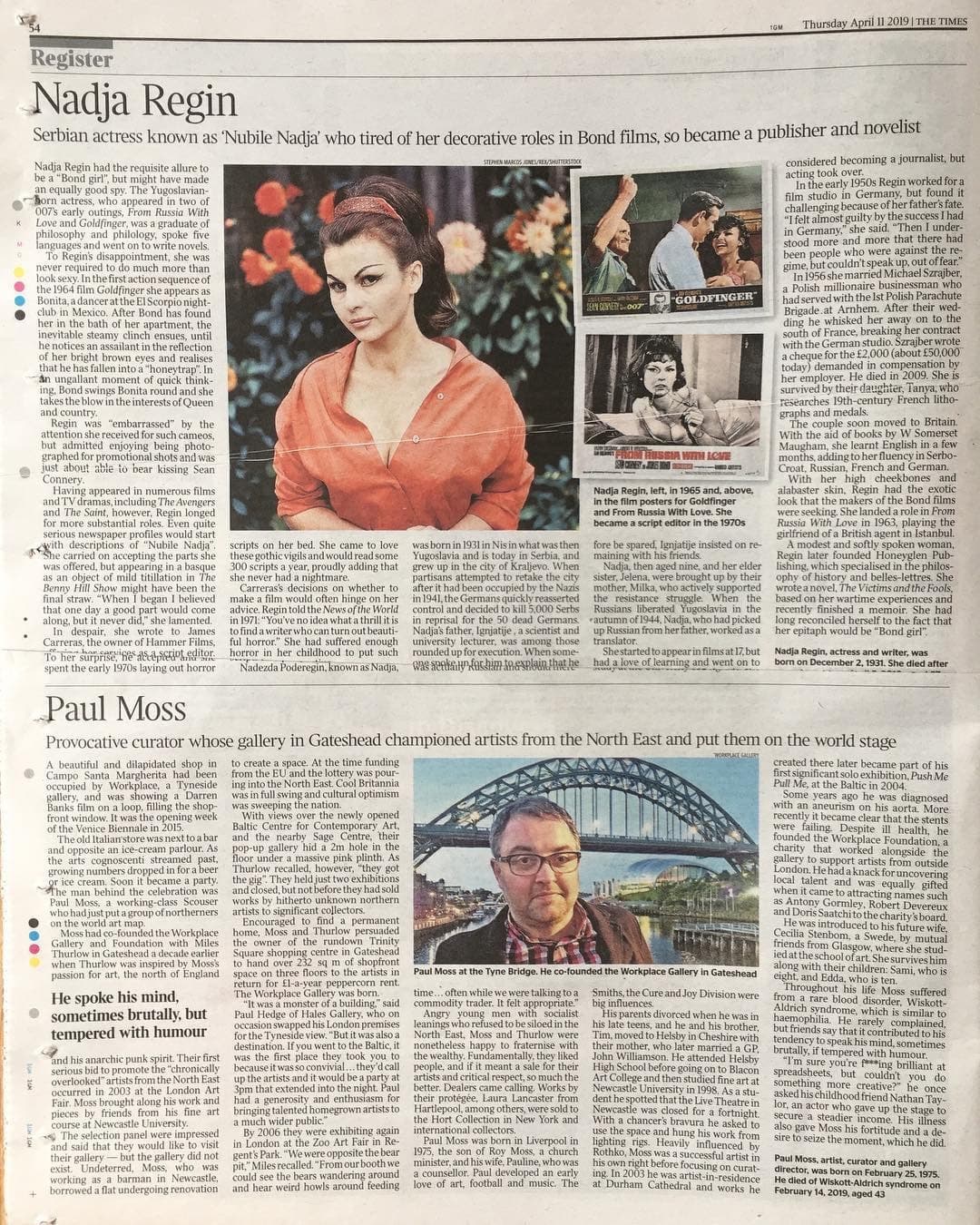Paul Moss
Provocative curator whose gallery in Gateshead championed artists from the North East and put them on the world stage
Alexandra Blair
A beautiful and dilapidated shop in Campo Santa Margherita had been occupied by Workplace, a Tyneside gallery, and was showing a Darren Banks film on a loop, filling the shopfront window. It was the opening week of the Venice Biennale in 2015.
The old Italian store was next to a bar and opposite an ice-cream parlour. As the arts cognoscenti streamed past, growing numbers dropped in for a beer or ice cream Soon it became a party. The man behind the celebration was Paul Moss. a working-class Scouser who had just put a group or northerners on the word art map.
Moss had co-founded the Workplace Gallery and Foundation with Miles Thurlow in Gateshead a decade earlier when Thurlow was inspired by Moss's passion for art. the north of England and his anarchic punk spirit. Their first serious bid to promote the "chronically overlooked" artists from the North East occurred in 2003 at the London Art Fair. Moss brought along his work and pieces by friends from his fine art course at Newcastle University.
The selection panel were impressed and said that they would like to visit their gallery - but the gallery did not exist. Undeterred, Moss, who was working as a barman in Newcastle, borrowed a flat undergoing renovation to create a space. At the time funding from the EU and the lottery was pouring into the North East. Cool Britannia was in full swing and cultural optimism was sweeping the nation.
With views over the newly opened Baltic Centre for Contemporary Art, and the nearby Sage Centre, their pop-up gallery hid a 2m hole in the floor under a massive pink plinth. As Thurlow recalled, however, "they got the gig". They held just two exhibitions and closed. but not before they had sold works by hitherto unknown northern artists to significant collectors.
Encouraged to find a permanent home, Moss and Thurlow persuaded
the owner of the run down Trinity Square shopping centre in Gateshead to hand over 232 sq m of shopfront space on three floors to the artists in return for £1-a-year peppercorn rent.
The Workplace Gallery was born.
"It was a monster of a building." said Paul Hedge of Hales Gallery, who on occasion swapped his London premises for the Tyneside view. "But it was also a destination. If you went to the Baltic, it was the first place they took you to because it was so convivial... they'd call up the artists and it would be a party at 3pm that extended into the night. Paul had a generosity and enthusiasm for bringing talented homegrown artists to a much wider public."
By 2006 they were exhibiting again in London at the Zoo Art Fair in Regent's Park. “We were opposite the bear pit," Miles recalled. "From our booth we could see the bears wandering around and hear weird howls around feeding
time... often while we were talking to a commodity trader. It felt appropriate."
Angry young men with socialist leanings who refused to be siloed in the North East. Moss and Thurlow were nonetheless happy to fraternise with the wealthy. Fundamentally, they liked people. and if it meant a sale for their artists and critical respect, so much the better. Dealers came calling. Works by their protégée, Laura Lancaster from Hartlepool, among others, were sold to the Hort Collection in New York and international collectors.
Paul Moss was born in Liverpool in 1975, the son of Roy Moss, a church minister, and his wife, Pauline, who was a counsellor. Paul developed an early love of art, football and music. The Smiths, the Cure and Joy Division were big influences.
His parents divorced when he was in his late teens, and he and his brother, Tim, moved to Helsby in Cheshire with their mother, who later married a GP.
John Williamson. He attended Helsby High School before going on to Blacon Art College and then studied fine art at Newcastle University in 1998. As a student he spotted that the Live Theatre in Newcastle was closed for a fortnight. With a chancer's bravura he asked to use the space and hung his work from lighting rigs. Heavily influenced by Rothko, Moss was a successful artist in his own right before focusing on curating. In 2003 he was artist-in-residence at Durham Cathedral and works he created there later became part of his first significant solo exhibition, Push Me Pull Me, at the Baltic in 2004.
Some years ago he was diagnosed with an aneurism on his aorta. More recently it became clear that the stents were failing. Despite ill health, he founded the Workplace Foundation, a charity that worked alongside the gallery to support artists from outside London. He had a knack tor uncovering local talent and was equally gifted when it came to attracting names such as Antony Gormley, Robert Devereux and Doris Saatchi to the charity's board.
He was introduced to his future wife, Cecilia Stenbom, a Swede, by mutual friends from Glasgow, where she studied at the school of art. She survives him along with their children: Sami, who is eight, and Edda, who is ten.
Throughout his life Moss suffered from a rare blood disorder. Wiskott-Aldrich syndrome, which is similar to haemophilia. He rarely complained, but friends say that it contributed to his tendency to speak his mind, sometimes brutally, if tempered with humour.
"I'm sure you're f***ing brilliant at spreadsheets, but couldnt you do something more creative?" he once asked his childhood friend Nathan Taylor, an actor who gave up the stage to secure a steadier income. His illness also gave Moss his fortitude and a desire to seize the moment, which he did.
Paul Moss, artist, curator and gallery director, was born on February 25, 1975. He died of Wiskott-Aldrich syndrome on February 14, 2019, aged 43



